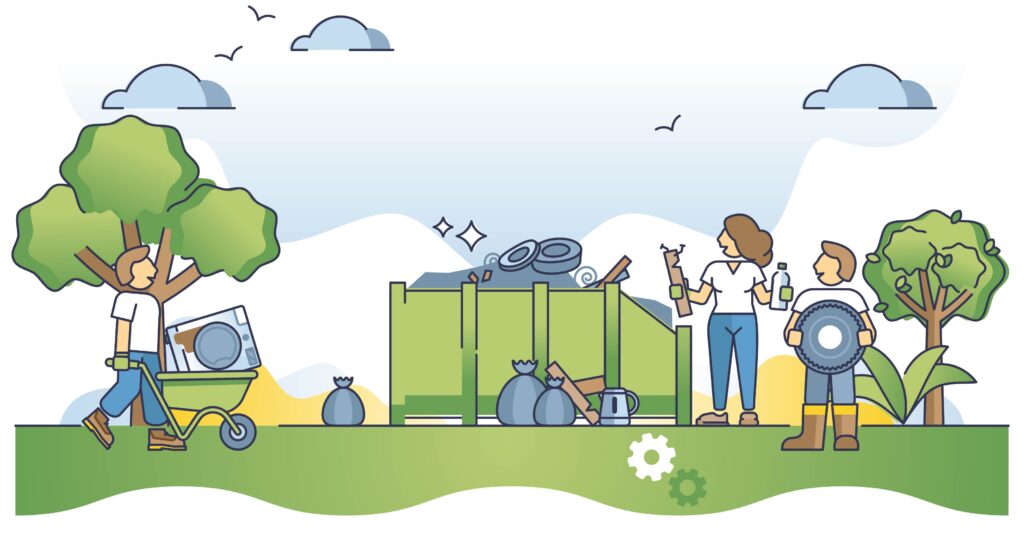How Much Garbage Do We Make?
On average, each one of us produces 4.5 pounds of solid waste each day. This adds up to almost a ton of trash per person, per year. In Connecticut we generate close to 3,000,000 tons each year.
On average, each one of us produces 4.5 pounds of solid waste each day. This adds up to almost a ton of trash per person, per year. In Connecticut we generate close to 3,000,000 tons each year.
EPA estimates that 75% of what Americans throw in the trash could actually be recycled.
Recycling vs. Incinerating
Incinerating 10,000 tons of waste creates one job; recycling 10,000 tons of waste creates 36 jobs.
National Recycling Rate
The national recycling rate of 30% saves the equivalent of more than five billion gallons of gasoline, reducing dependence on foreign oil by 114 million barrels per year.

How we handle our solid waste has changed dramatically over the past 25 years. As recently as 1975, 140 of Connecticut’s 169 towns disposed of their trash within their own borders. Today, only two municipalities operate their own landfills to dispose of residential trash. What happened? In the late 1980s and early 1990s, it became apparent that dozens of municipal landfills would have to close. Many had reached their permitted capacity, while others were unable to meet new federal regulatory requirements for modern sanitary landfills. Some even posed a contamination threat to drinking water supplies. An important step was taken toward changing the way we manage our MSW when Connecticut adopted a solid waste management hierarchy which utilizes first source reduction, then recycling, composting, waste-to-energy and finally landfilling as the preferred methods to handle our trash. To implement this hierarchy, the State legislature passed the Mandatory Recycling Act (PA 87-544) which required recycling of 25% of the state’s solid waste stream by January 1, 1991. To meet this goal, 9 items were designated which could not be disposed of and had to be recycled instead.
For residents new to the area, garbage and recycling collection in the region is provided by private subscription service with a solid waste hauler chosen by the resident. So how do you go about choosing a hauler? Below are some tips that other residents have found useful
Click here to choose a hauler from the chart of registered businesses who are permitted to collect in the municipality where you live. Registered haulers are legally able to collect in the community and maintain the appropriate insurances, licenses and vehicle registrations.
Consider a hauler who offers unit-based pricing to insure that you only pay for the waste that you produce.
Call several registered haulers and check their prices. Be sure to ask about unit-based pricing.
Be sure and tell potential haulers about any special circumstances you have or services you want such as garage pick up rather than curbside or steep driveway or senior citizen, etc.
Ask potential haulers about pricing for occasional oversize items you may want to leave out for pick up.
Ask potential haulers if they will provide you with containers, bins, toters, etc. for trash and recycling.
Ask your neighbors who they use and if they’re happy with their hauler.
We put our trash and recyclables at the curb or drop them off at the local transfer station and then what? Ever wonder what happens next?
Did you think it goes to a landfill? Not in Connecticut! We closed all our landfills many years ago. Waste in Connecticut gets burned and is made into energy. That energy powers homes.
Trash disposed of within the HRRA region goes first to one of three transfer stations in the region, located in Danbury, Newtown and Ridgefield. From the transfer station the trash is loaded into large tractor trailer trucks and shipped to the Wheelabrator waste-to-energy plant in Bridgeport, CT.
The Wheelabrator Bridgeport waste-to-energy facility provides dependable, environmentally safe disposal of municipal solid waste for more than two dozen towns and cities in Connecticut, while generating clean, renewable electricity for sale to the local utility. The plant processes up to 2,250 tons per day of garbage. Wheelabrator Bridgeport has an electric generating capacity of 67,000 kilowatts; the equivalent of supplying the electrical needs of 83,000 Connecticut homes.